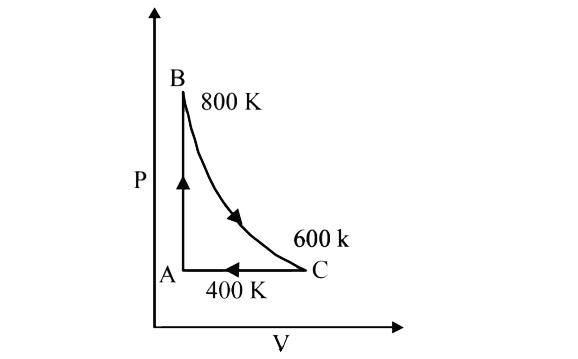A reversible heat engine carries 1mol of an ideal monatomic gas around the cycle ABCA, as shown in the diagram. The process BC is adiabatic. Call the processes AB,BC and CA as 1,2 and 3 and the heat (ΔQ)r, change in internal energy (ΔU), and work done (ΔW)r,r=1,2,3 respectively. The temperature at A,B,C are T1=300K,T2=600K and T3=455K. Indicate the pressure and volume at A,B andC by Pr and Vr,r=1,2,3, respectively. Assume that intially pressure P1=1.00atm.
Which of the following represents the correct values of the quantities indicated ?

(ΔQ)=450RJ,(ΔU)1=450RJ,(ΔW)1=300RJ
(ΔQ)2=0,(ΔU)2=450RJ,(ΔW)2=−217.5RJ
(ΔQ)3=0,(ΔU)3=−232.5RJ,(ΔW)3=0
(ΔQ)1=450RJ,(ΔU)3=−232.5RJ,(ΔW)2=217.5RJ
The correct Answer is:D
Process 1 is isochoric. Now work is done Dw=0
Hence, (ΔQ)1=dU=CV(T2−T1)
=3R2[600−300]=450RJ
Process 2 is adaibatic expansion
(ΔQ)2=0,(ΔW)2=−(ΔU)2
(ΔW)2=−[Cv(T3−T2)]
=−[3R2(455−600)]
=3×1452R=217.5RJ
(ΔV)3=Cv−217.5RJ
Process 3 is isobaric compression.
Value of pressure =1atm=1.013×105N/m2
(ΔW)3=1.013×105(Vc−VA)J=0
(ΔW)3=Cv(300−455)=−3R2×155=−232.5R
Topper's Solved these Questions
- KINETIC THEORY OF GASES AND FIRST LAW OF THERMODYNAMICSBOOK - CENGAGE PHYSICS ENGLISHCHAPTER - KINETIC THEORY OF GASES AND FIRST LAW OF THERMODYNAMICSEXERCISE - Interger
11 Videos
- KINETIC THEORY OF GASES AND FIRST LAW OF THERMODYNAMICSBOOK - CENGAGE PHYSICS ENGLISHCHAPTER - KINETIC THEORY OF GASES AND FIRST LAW OF THERMODYNAMICSEXERCISE - Assertion-Reasoning
6 Videos
- KINETIC THEORY OF GASESBOOK - CENGAGE PHYSICS ENGLISHCHAPTER - KINETIC THEORY OF GASESEXERCISE - Compression
2 Videos
- LINEAR AND ANGULAR SIMPLE HARMONIC MOTIONBOOK - CENGAGE PHYSICS ENGLISHCHAPTER - LINEAR AND ANGULAR SIMPLE HARMONIC MOTIONEXERCISE - Single correct anwer type
14 Videos
Similar Questions
A reversible heat engine carries 1 mole of an ideal monatomic gas around the cycle 1-2-3-1. Process 1-2 takes place at constant volume, process 2-3 is adiabatic, and process 3-1 takes place at constant pressure. Complete the values for the heat ΔQ, the change in internal energy ΔU, and the work done Δ, for each of the three processes and for the cycle as a whole.

View SolutionOne mole of a monatomic ideal gas is taken along the cycle ABCA as shown in the diagram.

The ratio of specific heat in the process CA to the specific heat in the process BC is
View Solution
Knowledge Check
The cyclic process for 1 mole of an ideal gas is shown in the V-T diagram. The work done in AB, BC and CA respectively is
 A0,RT1Ln(V1V2),R(T1−T2)BR,(T1−T2)R,RT1In(V1V2)C0,RT2ln(V2V1),RT1V1(V1−V2)D0,RT2ln(V1)V2,R(T1−T2)
A0,RT1Ln(V1V2),R(T1−T2)BR,(T1−T2)R,RT1In(V1V2)C0,RT2ln(V2V1),RT1V1(V1−V2)D0,RT2ln(V1)V2,R(T1−T2)
One mole of a diatomic ideal gas undergoes a cyclic process ABC as shown in figure. The process BC is adiabatic. The temperature at A,B and C are 400K, 800K and 600K respectively. Choose the correct statement:

View SolutionOne mole of a diatomic ideal gas undergoes a cyclic process ABC as shown in figure. The process BC is adiabatic. The temperature at A,B and C are 400K, 800K and 600K respectively. Choose the correct statement:

View SolutionAn ideal monoatomic gas undergoes a cyclic process ABCA as shown in the figure. The ratio of heat absorbed during AB to the work done on the gas during BC id

View SolutionAn ideal monoatomic gas undergoes the process AB as shown in the figure. If the heat supplied and the work done in the process are ΔQ and Delta Wrespectively.TheratioDeltaQ : DeltaW is

View SolutionOne mole of an ideal monoatomic gas undergoes a cyclic process, as shown in the figure. If the temperature of the gas at state 1 is 300 K and at state 4 is 500 K, then heat exchanged during process 2→3, is

View SolutionThe cyclic process for 1 mole of an ideal gas is shown in the V-T diagram. The work done in AB, BC and CA respectively is

View SolutionTwo moles of an ideal monoatomic gas is taken through a cycle ABCA as shown in the p - T diagram. During the process AB, the pressure and temperature of the gas vary such that pT = constant. If T1=300K and the amount of heat released by the gas during the process AB is Q=−xR, then the value of x is

View Solution
